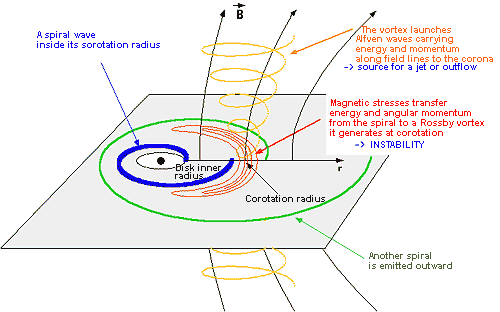


Instability - AEI Presentation
The Accretion-Ejection Instability
The AEI is a spiral instability, similar to galactic spiral density waves but driven by magnetic stresses rather
than self-gravity (Tagger & Pellat, 1999). It occurs in the inner region of an accretion disk threaded by a
vertical magnetic field when the latter is of the order of equipartition with the gas pressure, i.e. a plasma ![]() .
.
This magnetic configuration is also the one used as an initial condition in almost all MHD jet models (for e.g. Blandford Payne 1982, Pelletier & Pudritz, 1992). Because of the strong magnetic field required, this instability develops in a region where the Magneto-Rotational Instability (MRI, Balbus & Hawley, 1991) has likely shut down.
The origin of such a strong magnetic field may come from an in situ large scale
helical dynamo (e.g. Blackman & Field 2002) or be accreted from the exterior with the flow. Regardless of the
origin of such a field, its plausibility is supported by observations of our Galactic center where strong vertical
magnetic filaments with ![]() are observed. (e.g. Chandran, Cowley & Morris 2000).
are observed. (e.g. Chandran, Cowley & Morris 2000).
The AEI creates a 1-armed spiral pattern rotating in the disk at a frequency of the order of a few tenths
of ![]() (i.e. 1/10 the rotation frequency at the inner edge of the disk).
(i.e. 1/10 the rotation frequency at the inner edge of the disk).
The spiral grows by extracting energy and angular momentum from the inner region of the disk, and stores them in a Rossby vortex generated at its corotation radius. This exchange of energy and angular momentum makes the whole perturbation (density wave + Rossby wave) unstable.
With this instability, accretion energy and angular momentum are transported by waves and do not heat up the disk, except by spiral shocks.

The structure of the instability is shown schematically. It is formed of a standing spiral density wave in the inner
part of the disk coupled to a Rossby vortex it excites at itscorotation radius.
The Rossby vortex generates Alfven waves
propagating toward the corona of the disk.
This figure illustrates the instability mechanism. A standing wave pattern forms, similar to spiral waves in galaxies. The spiral wave propagates outward from the inner radius of the disk until it is reflected at corotation. In this process the Rossby wave becomes a standing vortex, rotating at the angular velocity of the pattern.
This basic physical description was obtained from the simple model of a thin disk in vacuum, and numerical
solutions were given in TP99. If one takes into account a low density corona above the disk, the vortex then
leaks energy and angular momentum as Alfven waves to the corona, where it might power a wind or a jet. The
computation of the associated Alfven wave emission was done in Varniere and Tagger, 2002, which revelealed
that a large amount of the accretion energy is sent toward the corona as Alfven waves. The AEI thus appears
to be a good candidate to connect accretion and energy ejection in the inner region of a magnetized disk.